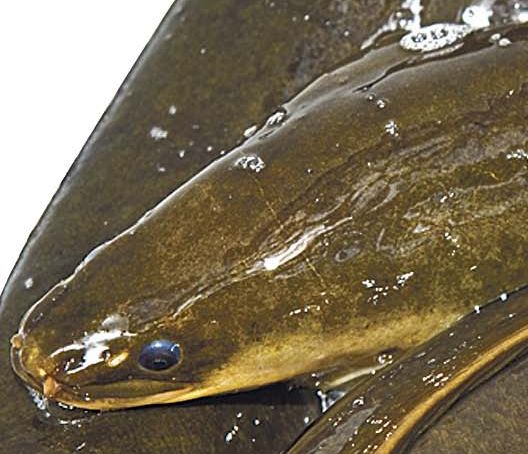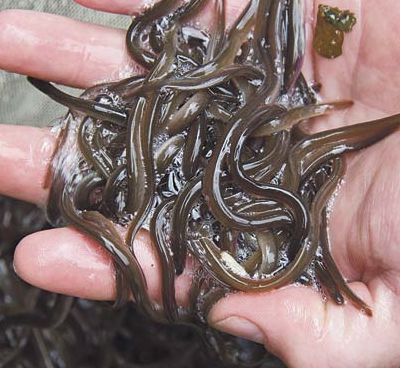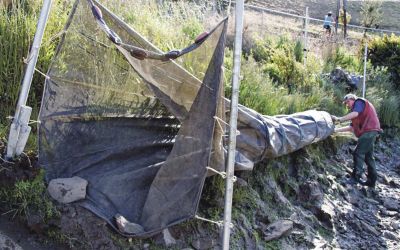 Presented from Issue 113, December 2014
Presented from Issue 113, December 2014
Aunique partnership between Hydro Tasmania, the Inland Fisheries Service (IFS) and professional eel fishermen is boosting the health of Tasmania’s inland waterways and the sustainability of the State’s growing commercial eel fishery.
Tasmania has the most predictable and high quality juvenile eel migrations within Australian waters, but 50 major dams built for the creation of hydroelectricity obstruct these upstream migrations. So IFS and Hydro Tasmania give hundreds of thousands of elvers (baby eels) a metaphorical leg up into the Hydro catchments and the eel fishers translocate as many more to other inland waters around the State.
The IFS annual elver harvesting and restocking programs support the wild fishery in Tasmania’s rivers and lakes, where eels are a vital part of the ecosystem as the only large, native, predatory fin fish. Hydro Tasmania has a responsibility for 53 of Tasmania’s major lakes and at least 1200 km of natural creeks and rivers are influenced by their operations in some way.
 |
 |
“The elvers migrate upstream to find a water inland to feed and grow to sexual maturity, then they head back downstream and out to sea to their breeding grounds,” says Brett Mawbey, who manages the IFS elver programs. “However, their migration is impeded in many places by Hydro structures, so we work with Hydro Tasmania to get around that problem.”
IFS personnel catch elvers in fine-meshed fyke nets at the Trevallyn Power Station tailrace at Ti-Tree Bend on the Tamar River and collect more from the Lake Meadowbank Dam fish trap on the Derwent River.
Hydro Tasmania assist in both these undertakings: whenever possible they increase the water flow from the tailrace to attract the elvers when IFS are harvesting elvers in the Tamar, and the fish trap is at the end of a ladder Hydro Tasmania built into the Meadowbank dam wall to assist elvers and lampreys to surmount the obstacle.
About 1000 kgs of elvers are harvested annually, each kilogram comprising about 900 fish. Hydro Tasmania has contracted IFS to translocate 400kg into Hydro catchments, and pays them to do so. David Ikedife, a specialist environmental scientist with Hydro Tasmania’s consulting arm Entura, says that the ecology of the catchments is the primary concern.
“Eels are a key native species and an important component of the ecological system,” says David. “We have to ensure that we have a good recruitment structure in our catchments, and do whatever we can to help IFS in this regard.”
Entura is also researching safe passages for the grown eels to migrate downstream. Although they can get over the dam wall when the water spills, and through the valves that release water, most eels travel via the turbines, where a portion get through but many die.
“We are about sustainability and innovation, and while we are satisfied with the way we are getting them upstream, we want to complete the circle and get them safely downstream as well,” says David.
David says that although Hydro Tasmania’s concern is predominantly environmental, it will support the commercial fishers where possible, and Brett Mawbey says IFS must balance all interests.
“Eels are a very important part of the food chain, and keep everything in check,” says Brett. “They are also a valuable source of food for humans worldwide, so a healthy commercial fishery is important as well.” Tasmania’s annual commercial eel catch is about 75 tonnes: 98 per cent are Short-finned eel, the rest Long- finned eel. It is a limited entry fishery comprising 12 commercial fishing licences (including one for Flinders Island and one for King Island), each with a discrete area to fish but no catch limits. Some 30 fishers are seasonally employed in the industry. The main capture method is fyke nets, modified to prevent by-catch such as platypus, and there is also some downstream trapping of migrating adult eels.
Each licence holder is entitled to 50kgs of elvers for free from IFS, and more can be bought if required. The fishers must translocate the elvers allocated to a particular licence into the designated catchment area of that licence, in consultation with IFS.
Veteran professional eel fisherman Wayne Finlayson, whose family own four licences and net about half of the entire annual Tasmanian catch, is proud of his family’s work to not only sustain the fishery, but to enhance it.
“We translocate a couple of hundred kilos of elvers every year and we also relocate juvenile eels as part of the restocking process,” says Wayne. “We also catch pest species like carp on behalf of the IFS. There is no water that we work on that we do not try to improve.”
All elvers harvested by IFS are taken to Wayne’s eel holding facility at Bagdad, where they are graded under a stringent protocol overseen by IFS to ensure introduced and undesirable native fish species are not translocated with the elvers.
If IFS has surplus elvers, they can be sold for as much as $250 a kg. Some have gone to China for fish farms and others to Victoria to restock local waters.
A slippery business and a wonder of the world
 |
| Setting fyke nets at Riverside’s tail race. |
Wayne Finlayson has spent much of the last half century catching eels, yet remains fascinated by the enigmatic creatures.
“I’ve spent a lifetime trying to figure them out, and they still surprise me,” says Wayne, who first fished professionally for eels with his father as a school boy in the early 1960s. “For example, I have seen them congregate in large numbers until they mass into a ball and then roll together over obstacles. They are a wonder of the world.”
Today, Wayne, his wife Margaret and his son Shaun between them own four of mainland Tasmania’s 10 commercial eel fishing licences, and the processing facility Wayne designed and built adjoining his Bagdad home takes all the eels caught in the State. From there they go regularly to Asia (mainly live) and Europe (mainly frozen), and sometimes to New York, with a small amount sold locally and on the mainland. Total catch for Tasmania is about 75 tonnes a year, with the Finlaysons bagging about half that, and the gross export value about $1.25 million.
While the Finlaysons – including Bradley, who recently returned home from Western Australia to fish with his dad Wayne and brother Shaun – make a decent living out of eels today, it has not always been so. Since going into partnership with his father in the early 1970s after completing a plumber’s apprenticeship, Wayne has seen good times and bad, and been driven out of business more than once. But he persevered with eel fishing for one reason: he absolutely loves it.
“It gets into your blood,” says Wayne. “You see incredible things and go to so many beautiful places that other people rarely see. It is just such an enjoyable job.” Wayne loves the travel, which is just as well because there is a lot of it. Each licence allows fishing within a designated catchment: the Finlaysons’ four areas are on the north east coast, the far north west, the South Esk catchment and the east coast and Midlands. They fish countless farm dams and lakes in those places, and as each expedition involves at least two days work – one to set up the nets and another to take the catch – there is plenty of driving and camping, as well as pre-dawn starts and late finishes. The work is hard and physical, in fair weather or foul, although they do not fish in the winter months as the eels are largely dormant then.
The Finlaysons fish from large, flat-bottomed dinghies – designed by Wayne, like much of the their operational equipment: “I pride myself on my ability to make things work,” he says, without conceit. Numerous tunnel-shaped fyke nets are stretched in rows around a water, just below the surface, with a net barrier extended near each row. When the eels swim into the barrier, they turn and travel along it into an opening in the fyke net, and become trapped inside. The fishers pull each net by hand and dump the madly flapping and writhing eels into a large plastic bin. When the bin is full the eels are tipped into a mesh bag, which is then lifted back into the water and attached to a submerged pole. All the bags are regathered at once when the water has been fished to its full potential.
 |
| Wayne Finlayson sorting eels. |
Sometimes several hundred kilograms of eels are taken in a couple of nights, and the catch is lifted by the fisher numerous times before it is tipped into a tank on the tray of a truck for transport back to Bagdad. The Finlaysons do all the processing by hand as well, and the fish are handled more times still at the plant before being exported alive, usually in a bag full of pure oxygen inside a polystyrene box in planes bound for niche markets in China, Japan, Korea and Taiwan. The ideal size for an exported live eel is about 700 grams.
“Wild Tasmanian Short finned eels are prized in Asia, but are not a premium product as such,” says Wayne, who has travelled to Asia to investigate and cultivate the markets. “They grow slowly and are older and tougher than the Asian farmed eels, which are grown out in ponds very quickly and have soft, delicate flesh.
But wild Short finned eel deep fries beautifully and in a light batter is to die for: it tastes delicious and just melts in your mouth. It is also perfect for smoking, which is what the Europeans prefer to do with it: they like them big and juicy, a kilo plus, with high oil content. Our eels are sought after more and more in Europe because they are catching less and less of their own.
“The Chinese, on the other hand, prefer our Long finned eel, which they consider has special properties and is an aphrodisiac. These are slower-growing, bigger and a lot more aggressive than Short finned eels and we have to be pretty careful when we handle them.”
Wayne sees a good future and a growing market for Tasmanian eels, and also great potential for a much larger catch through unexploited waters and new dams. He is also researching ways to prevent eels from being destroyed by the turbines in Hydro dams, which he says could boost the eel population significantly.
The Finlaysons are partners in Highland Pacific Exports, responsible for the catch and export of 95 per cent of the Tasmanian eel catch. The company is mainly focused on the live eel trade but has partners able to process the fish into a gutted and frozen product to meet the buyer’s specification and market requirements.
Incredible and mysterious creatures
The extraordinary life cycle of Anguilla australis, Tasmania’s most common eel, demands incredible feats of strength and endurance by these mysterious creatures.
Commonly known as Short-finned eels, they are believed to spawn somewhere in the Coral Sea, at depths of about 300 metres, although exactly how, when and where is not certain. Large breeding females, bigger than their mature male counterparts at up to 1.1 m long and 32 kg in weight, can contain as many as 10 million eggs. Once fertilised, the leaf-shaped eel larvae are swept south in the East Australian Current until they reach the continental shelf, when they metamorphose into an eel shape. Known as glass eels because of their transparent flesh, these tiny creatures move into Tasmanian estuarine waters from March to November, quickly adjusting to fresh water and transforming into pigmented elvers. By then they are up to three years old.
The elvers then commence their migration inland, usually at night, and spend several years heading upstream from the estuaries. They can overcome obstacles as large as a waterfall by travelling overland like snakes when ground conditions are damp enough up for them to slide along.
The young eels settle in creeks, rivers, swamps, dams and lakes, preferring a still water habitat, where they feed on a variety of aquatic fauna including insects, crustaceans, molluscs, frogs and fish. They have nocturnal and obscure habits, but may be seen moving into shallow areas on dusk to feed. Feeding eels are believed to occupy a definite home range. They can also hibernate or enter a period of dormancy over winter due to low temperatures, and have been known to bury themselves in damp mud when the water dries up.
Adults vary in colour from dark brown to black on backs and sides. During the years they spend in their freshwater homes feeding and growing, the eels have a yellowish belly and are known as yellow eels. When they reach sexual maturity, the males between eight and 12 years and the females between 10 and 20 years of age, their belly turns a pale silvery colour, and they are known as silver eels. The mature eels migrate downstream on a long, exhausting mission to reproduce, eventually returning to their spawning grounds in the Coral Sea more than 2000km from Tasmania, where they spawn and die. By then the males are as old as 25 and the females 35
Tasmania’s next most common eel, Anguilla reinhardtii or Long-finned eel, are dark greenish-brown to black with a mottled or spotted appearance on the back and sides and a lighter belly. They grow slowly, up to 1.5 m in length and up to 20 kg in weight, and may be as old as 50 years when they migrate back to the sea. Like the Short-finned eel, they are believed to spawn in the Coral Sea, and follow the same migration routes. Anguilla reinhardtii has a similar life cycle to Anguilla australis, and much the same diet, although big long-finned eels have been known to eat small water fowl. They live in a wide range of freshwater habitats, but are not as common in lakes.
Eel fishers are an asset for trout fishers and IFS. Respect them and their gear.
Eel fishers help IFS monitor inland waters for environmental health and ensure there are no introduced species.
If you see nets in the water please stay clear as the chance of entanglement with props is something both parties don’t wish to see.
All nets are set from the shore out to a max 25-35 metres and marked with either a wooden stake or floating buoy.
When eel fishers are at a public water there will be signs at the boat ramp with contact details for the current eel fisherman on site.
Eel fishers try and minimise the impact to the trout fisherman.
Most public waters are only eel fished for a short time.
Please respect the eel fishers and stop for a chat if you see them. They might even give you some trout tips.
Brad Finlayson from Tasmanian Eel Exporters can be contacted on 0409 686 472 or email: This email address is being protected from spambots. You need JavaScript enabled to view it.
All pictures by Simon de Salis.
Eel nets are set from the shore outwards. Boat anglers need to take care.






